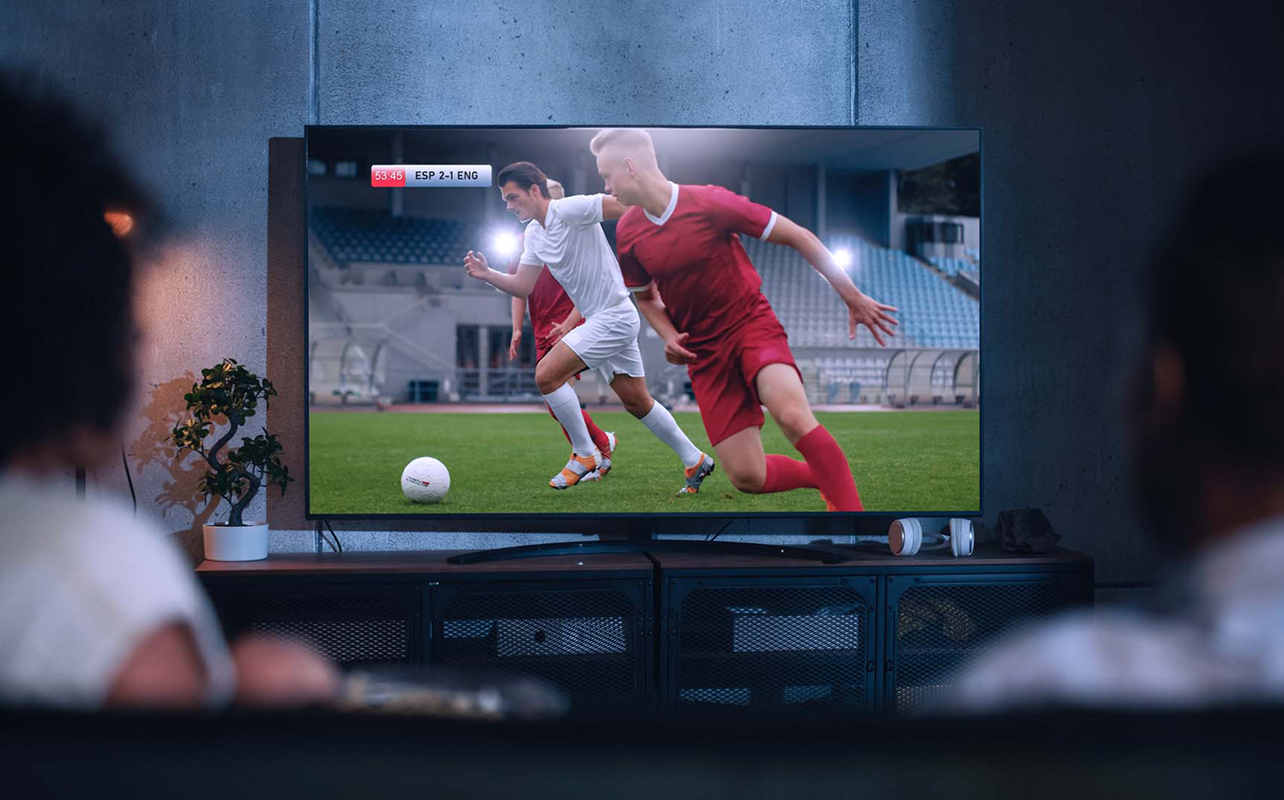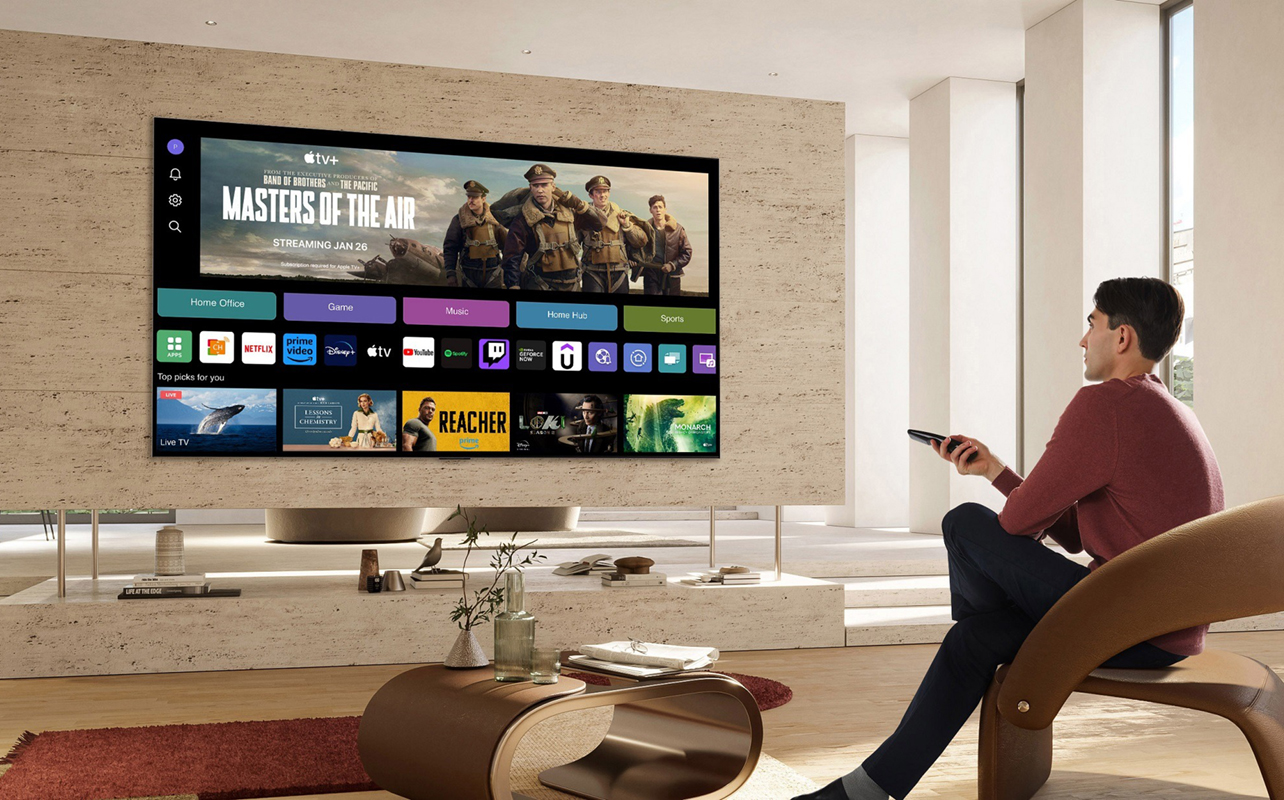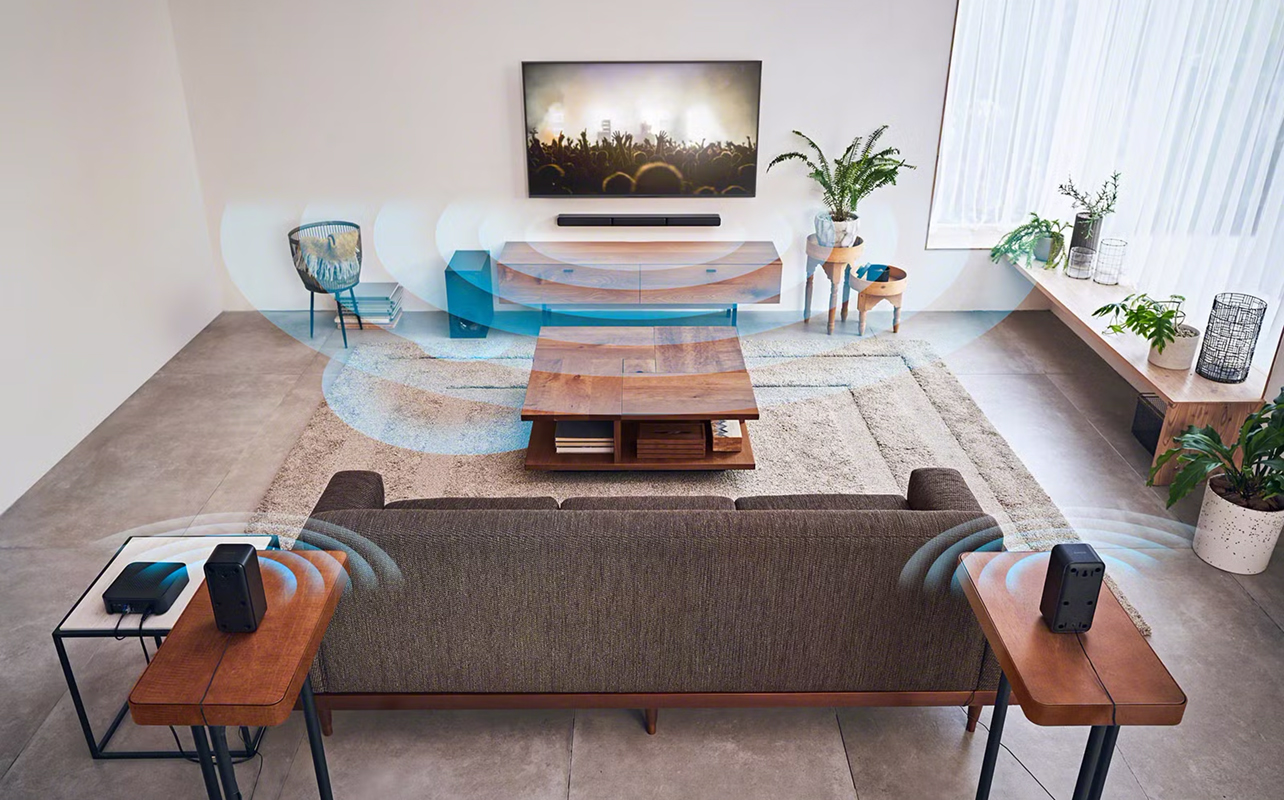
Buying a new TV isn’t just about picking the biggest screen on the shelf, it’s also about finding the perfect fit for your space, viewing habits, and budget. Considering these factors ensures that you select a TV that can both complement your home environment and meet your unique entertainment needs without overspending. The right TV can significantly enhance your entertainment experience whether you love movie nights, gaming, or binge-watching your favourite shows.
From 4K and OLED to smart features and advanced audio, it’s great to have a whole range of TV options to choose from—but it could also be overwhelming. And that’s where this guide comes in, as it breaks down everything you need to know about how to pick a TV that suits your needs. And when you’re ready to buy, Best Buy Canada offers a wide selection of top-rated TVs to explore.
Table of contents
- Viewing habits
- The right screen size
- Display technologies: LED vs. OLED vs. QLED
- Resolution matters
- Smart TV features
- Consider audio and sound
- Connectivity options
Viewing habits
Before choosing a TV, consider how you’ll use it. Think about whether you primarily watch movies, play video games, follow sports, or stream content. Understanding your habits will help you find a television that enhances your overall experience.
- Movies and TV shows: If you’re a movie lover, focus on finding a TV that enhances picture quality for cinematic visuals, deeper contrasts, and more immersive dark scenes.
- Gaming: For gamers, TVs with faster screen refresh rates are important because they deliver smoother and more responsive gameplay, reducing lag and motion blur during fast-paced action.
- Sports: It’s a similar story with sports, where fast-moving scenes do better with a TV that keeps up with the action, ensuring clarity and reducing motion blur for an uninterrupted experience.
- Streaming: If you rely on streaming services, a smart TV with strong connectivity ensures smooth access to your favourite content without interruptions.
The type of content you watch is a big part of the equation but so is your viewing environment. If your room has a lot of natural light, a TV with high brightness can help counteract glare and maintain vibrant colours. In a darker viewing space, certain TVs excel by delivering superior contrast and deep black levels, enhancing immersion. Additionally, consider what seating looks like in the room. If it’s spread out, a TV with a wider viewing angle means everyone in the room can see the same high-quality picture, regardless of their position.
The right screen size

Does screen size matter? Two major factors can influence your decision: the size of your room and your viewing distance. A TV that’s too large for your space can overwhelm the room and cause eye strain, while a screen that’s too small may not provide an engaging viewing experience, especially if you have a family or group watching the same content. Measure your seating distance and assess your room’s layout to help you find the perfect size for a comfortable and cinematic experience.
Viewing distance
It’s pretty easy to figure out the ideal TV size based on how far you’ll be sitting from the screen. A general rule of thumb is:
- 1080p TVs: 1.5 to 2.5 times the diagonal screen size
- 4K TVs: 1 to 1.5 times the diagonal screen size
For example, a 55-inch TV is best viewed from 5.5 to 7 feet away, while a 65-inch TV suits a viewing distance of 6.5 to 8 feet. If you want a more cinematic experience, a 75-inch TV works best from 7.5 to 10 feet away, ensuring an immersive yet comfortable viewing experience. Sitting too close to a large screen can make images appear pixilated (especially on 720p or 1080p TVs), while sitting too far can make it difficult to appreciate finer details. 4K and 8K TVs allow you to sit closer while maintaining crisp image quality.
Room size and layout
Your room’s layout and furniture placement impact how well your TV fits into the space. If your room is compact, a large screen might dominate the area, making it feel cramped. On the other hand, a spacious room can accommodate a bigger TV without overwhelming it. Wall mounting can help maximize space and optimize viewing angles, especially in smaller areas. In a wider seating arrangement, consider a TV with excellent off-angle viewing to ensure everyone gets a clear picture, no matter where they sit.
Display technologies: LED vs. OLED vs. QLED vs. Mini-LED
TV display technology plays a crucial role in picture quality, affecting brightness, contrast, and viewing angles. There are differences between LED, OLED, QLED, and Mini-LED and it helps to understand them to help pick the right TV for your space and preferences.
- LED: Affordable, bright, available in various sizes, and best for well-lit rooms where brightness is essential to counteract glare. LED backlighting generally uses an array of small bulbs that can produce a clear, vibrant output. Its high brightness can work in a variety of lighting environments.
- OLED: Exceptional contrast, perfect black levels, and wide viewing angles contribute to an enhanced experience. Ideal for dark rooms and movie lovers who prioritize deep blacks and immersive visuals that truly bring films to life. Vivid colours and sharp details stand out. OLED TVs are preferable for home theatre enthusiasts seeking top-notch quality. They’re also thinner than other TV types because there’s no backlight. They’re also easier to mount.
- QLED: A great middle-ground between LED and OLED because of how quantum dots enhance brightness and colour accuracy, making it suitable for bright spaces. QLED technology takes advantage of the quantum dot filter to produce vivid images with deeper blacks and brighter whites. QLED display longevity and energy efficiency makes them popular for both casual viewers and cinephiles alike.
- Mini-LED: Excellent brightness with local dimming through thousands of smaller LEDs in the backlight. This helps produce better contrast with deeper blacks and reduced halo effects around bright objects on dark backgrounds. While not as effective as OLED since there is a backlight, local dimming really helps make darker scenes look more realistic, which is why they can also work well for movies, sports, and gaming.

Resolution matters
Higher resolution means sharper images, better details, and an overall improved viewing experience. However, choosing the right resolution largely depends on your screen size, viewing distance, and content availability.
- 1080p (Full HD): Still a good choice for smaller TVs, especially in situations where high resolution is not as critical, but it’s 1920 x 1080 resolution is becoming less common as 4K becomes the standard for most new televisions and streaming services, leading many to consider it a less desirable option for primary viewing, despite its adequate quality for various content types.
- 4K Ultra HD: The current industry standard, offering sharper images, richer colours, and better detail. This resolution, which measures 3840 x 2160 pixels, provides four times the pixel density of Full HD, ensuring that every scene is crisper and all visual details stand out more vividly. Most streaming services now support 4K content, including popular platforms like Netflix and Amazon Prime Video, so it’s a solid choice for most buyers who want to enjoy their favourite shows and movies in the best possible quality.
- 8K: Cutting-edge resolution with four times the detail of 4K, but limited content availability means it’s more of a future-proofing option for those with bigger budgets. As technology advances and more high-resolution content is developed, those who invest in 8K displays will find themselves ahead of the curve, enjoying enhanced viewing experiences that bring every detail to life. It’s just important to consider that current streaming services and broadcasts aren’t yet ready to fully utilize this impressive resolution, making it more suitable for early adopters and enthusiasts willing to wait for the content to catch up.
Smart TV features

Smart TVs offer a range of built-in features that enhance convenience and entertainment through a user interface that’s easy to manage. Built-in streaming services, voice assistants, and smart home integration provide a seamless experience tailored to modern viewing needs.
A smart TV’s biggest advantage is access to built-in streaming platforms like Netflix, YouTube, Disney+, Paramount+, Prime Video, and YouTube. This can eliminate the need for external streaming devices, and faster processors ensure smooth app navigation, quick loading times, and efficient multitasking between different applications.
Many smart TVs also come equipped with voice assistants such as Google Assistant, Alexa, or Apple’s Siri. This hands-free control feature allows you to search for content, control smart home devices, and even check the weather using just your voice. With seamless connectivity and intuitive functionality, smart TVs offer an all-in-one entertainment hub.
Consider audio and sound

A captivating picture can fall flat without clear and immersive sound to complement the viewing experience. Therefore, it’s essential to consider the audio capabilities, from built-in speakers to external sound systems, to ensure that your entertainment setup provides a fully engaging atmosphere.
Built-in speakers vs. soundbars/home theatre
Most TVs have basic built-in speakers that often deliver a mediocre audio experience. For a truly immersive experience, consider investing in a soundbar or a full home theatre system that can significantly enhance your sound quality. Soundbars provide a sleek, space-saving option with improved clarity and bass. They’re perfect for those who want better audio without a complicated setup.
On the other hand, a full home theatre system with multiple speakers placed strategically around the room offers an unparalleled level of immersion, allowing you to feel as if you are part of the action on the screen. While many modern TVs now come equipped with improved built-in speakers, they can’t match the power and audio quality of a soundbar or sound system.
Surround sound and Dolby Atmos
For a cinematic experience, look for Dolby Atmos support, which adds depth to sound and creates an immersive audio environment that allows you to feel as though you are at the centre of the action. This innovative technology utilizes overhead sound and multi-dimensional audio to provide a richer auditory experience, making it ideal for watching movies, playing video games, or listening to music that requires spatial awareness.
Add a subwoofer or satellite speakers and you can enhance the audio quality further by producing powerful bass and a more dynamic range of sounds. By strategically placing these additional speakers around the room, you can create a surround sound setup that envelops you, adding to the thrill and excitement of your favorite films and shows.
Connectivity options
When choosing a TV, determine how easily you can connect your devices and enhance your viewing experience, so you can have seamless integration with various gadgets and access to high-quality content and audio.
Modern TVs come with multiple HDMI ports, allowing you to connect gaming consoles, streaming devices, and sound systems without the hassle of constantly unplugging and replugging cables. USB ports also add versatility by enabling you to play media directly from external drives or charge peripherals. These connectivity options ensure your TV setup remains convenient and adaptable to various entertainment needs.
In addition to wired connections, wireless connectivity is crucial for a hassle-free experience. Built-in Wi-Fi allows for smooth streaming of movies, music, and videos without requiring additional hardware, while Bluetooth support lets you connect wireless audio devices such as headphones and speakers. These features make things convenient when you just want to enjoy a user-friendly and immersive viewing experience.
Refresh rate and gaming considerations

A TV’s refresh rate plays a significant role in how smooth motion appears on-screen and it’s a major factor for gamers and sports enthusiasts alike. A higher refresh rate reduces motion blur for clearer and more fluid action, which is vital for high-speed games and sporting events with constant movement.
Refresh rate
Standard TVs come with a 60Hz refresh rate, which is suitable for most content, including movies and casual gaming. Avid gamers and sports fans may prefer a 120Hz refresh rate since it provides smoother visuals with less motion blur. It also helps keep content sharper and more responsive for a more enjoyable experience.
Gaming features
Gaming features like VRR (Variable Refresh Rate) help prevent screen tearing by adjusting the refresh rate dynamically to match the game’s frame rate. ALLM (Auto Low Latency Mode) is another key feature that automatically switches the TV to its lowest lag setting when gaming, reducing input delay and making controls feel more responsive. These technologies help create a seamless gaming experience.
Budget
Setting a budget helps narrow your options and ensures that you get the best features for your price range. Whether you’re looking for an affordable upgrade or a premium home theatre experience, knowing what each budget level offers can help you make an informed decision.
- Entry-level: Ideal for those on a budget, these TVs typically feature 1080p or basic 4K resolution, offering decent picture quality at an affordable price. They’re great for secondary rooms or casual viewing.
- Mid-range: These models feature 4K resolution, Smart TV capabilities, and HDR (high dynamic range) support, making them a great choice for most households. They offer a good balance between price and performance, providing enhanced colour accuracy and streaming features.
- Premium: High-end TVs come with OLED or QLED technology, 120Hz refresh rates, and advanced sound systems, offering superior picture quality, contrast, and motion clarity. These are perfect for those looking for the ultimate viewing experience.
Check out the latest TVs on sale at Best Buy Canada.
Additional considerations
When purchasing a TV, it’s important to think beyond just display quality and features. Extended protection and professional setup services can help protect your investment and ensure the best possible viewing experience.
High-end TVs can be a significant upfront expense, so it can be worthwhile to look into an extended protection plan. Best Buy offers Best Buy Protection for that very reason, providing coverage against mechanical failures, power surges, and other unexpected issues.
For those who need assistance with installation, Geek Squad TV & Home Theatre Setup services offer professional mounting, cable management, and system calibration. Whether you’re setting up a simple entertainment area or a full home theatre, these services can optimize your setup for the best audio and visual performance.
Take your home theatre experience to the next level
How to pick the right TV is about more than just specs—it’s about creating the best entertainment setup for your home. Consider your viewing habits, space, and budget to find the perfect match. Think about how often you watch TV, whether you prefer binge-watching series or occasionally catching a movie, as this will help determine the size and features you need. Measure the space where the TV will go to ensure it fits well and complements your room’s aesthetics. And take your budget into account, as investing in the right technology—such as smart features and enhanced sound quality—can significantly elevate what it feels like to view your favourite content. Carefully evaluate these factors and you’ll make an informed choice that enhances your home entertainment experience.
Ready to upgrade your home entertainment? Find your perfect TV at Best Buy Canada.
This article was drafted using AI technology and then reviewed, fact-checked, and revised by a member of our editorial team.





